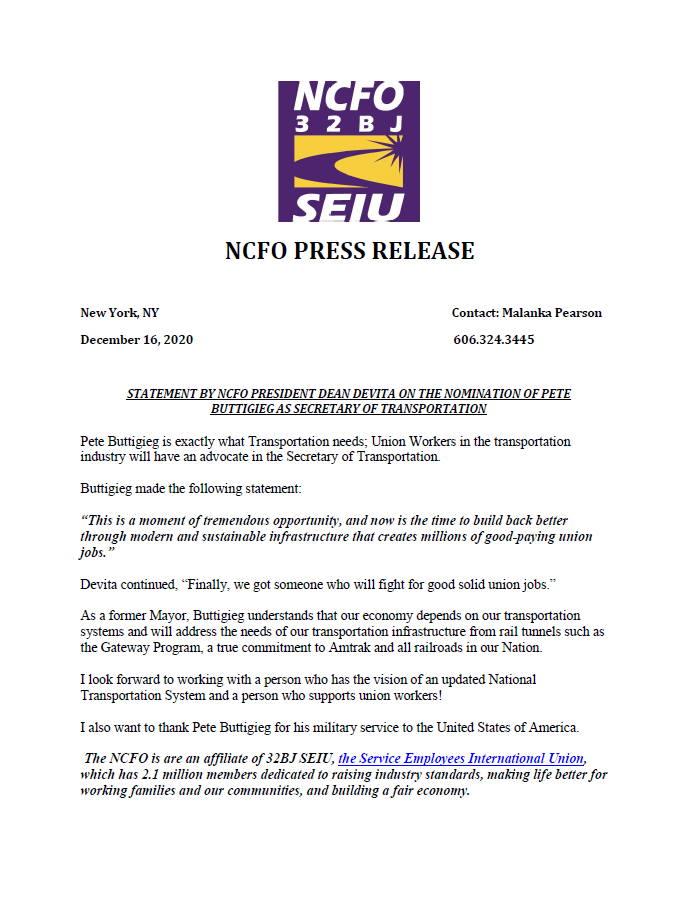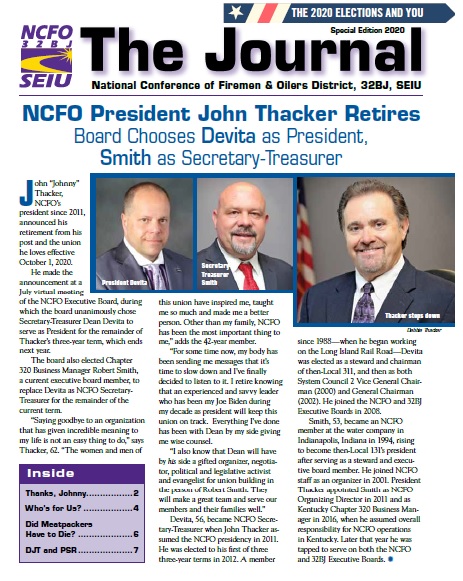Over the last several years, railroad industry stakeholders have become increasingly troubled by the effects of the new business model adopted by the Class I railroads. This so-called “precision scheduled railroading” focuses extensively on cost-cutting as a primary objective. Rail shippers complain of a deterioration of service and “de-marketing” of rail service. Rail employment was cut by about 20% in the last few years, which has necessarily impacted both rail safety and the quality of service.
Below is a statement endorsed by all of our rail partners from all of the rail unions, which explains how the confluence of dramatic deregulation, followed by government approval of the major merger and control transactions, that left America with a handful of mega-carriers, leading to the problems currently experienced by shippers, rail workers and communities.
On the 40th anniversary of the Staggers Act, it had substantial adverse effects on rail employees, and has facilitated the new rail business model that has further reduced employment and led to deterioration of service.
The major railroads are celebrating this anniversary. That is not surprising because deregulation of the railroad industry, along with post-Staggers government approval of mergers and control transactions, that have produced a highly concentrated, but lightly regulated, industry, have combined to produce a 20-year run of historic profits for the railroads, and record returns for their shareholders. In the recent past, shippers had no complaints about Staggers because shipping rates declined in real dollars; but they now worry about the quality of service and railroad responsiveness to their needs; as a concentrated, but deregulated industry that has little need to answer to its customers.
This is a particularly inopportune time to celebrate passage of the Staggers Act because, in recent years, finance interests have led or pressured the railroads to exploit the deregulatory regime formulated when they were in economic distress, to implement so-called “precision scheduled railroading”, and other cost-cutting measures that have eroded service and eliminated tens of thousands of good paying railroad jobs.
One group of major industry stakeholders never celebrated the Staggers Act: railroad workers. Between the passage of the Act and completion of the major merger and control transactions, rail industry employment was substantially reduced (from about 500,000 in 1980 to about 250,000 in the early 2000s).
Among other things, the Staggers Act facilitated sales of rail lines to smaller railroads that employed fewer workers, paid less and had less beneficial work rules. Those sales were accomplished without traditional employee protections. At first, the Interstate Commerce Commission approved these types of sales after concluding that the lines to be sold were likely to be abandoned. But then it began to approve sales of what it called “marginally profitable” lines (which, by definition, were somewhat profitable). The major rail carriers protected their own interests in these transactions; they placed restrictions on the sales (physical or contractual) so that the purchaser railroads could interchange traffic only with the seller carriers; that way the major carriers divested themselves of less profitable lines which gathered local freight, while ensuring that they retained the long haul movement of the freight generated on those lines. Rail Labor characterized these as sham transactions, but the ICC approved them citing the Staggers Act and the deregulatory spirit of the Act. The ICC also allowed companies that owned existing rail carriers to acquire new lines that often connected with the lines of their existing subsidiaries without employee protections that were required when rail carriers acquired lines from other rail carriers, by using the scheme of creation of new subsidiaries that the ICC treated as non-carriers since they were new corporations, even though they were commonly owned and controlled with existing carriers.
In approving the major merger and control transactions of the 1990s that reduced the number of Class I carriers to a mere handful, the ICC and Surface Transportation Board relied on Staggers Act amendments and the deregulatory mandate of the Staggers Act. Those transactions were approved based on the notion that shippers and the public would benefit from the consolidations. The railroads asserted, and the ICC and STB agreed, that mega-carriers would provide better and faster service through longer-end-to-end runs, reduced interchanges, and greater system velocity; that efficiencies would be achieved that would result in savings that would be passed along to shippers and the public in general; and that the economies of scale available to larger carriers would allow for increased investment in rail infrastructure.
During the same period that Congress and the ICC and STB deregulated the railroads and facilitated and approved consolidations as in the public interest, the agencies dramatically increased their regulation of Rail Labor by allowing the merging and commonly controlled rail carriers to use agency processes to gain dramatic changes in rates of pay, rules and working conditions outside the procedures of the Railway Labor Act. When the final big control transaction had been completed, railroad industry employment had been effectively halved, and rates of pay, rules and working conditions were forcibly and dramatically changed under the auspices of ICC and STB authorizations.
In the post-Staggers minimal regulation environment, after the big merger and control transactions were consummated, the profits of the new mega-carriers soared. And for a while, the railroads followed-through on their representations that service would improve, and infrastructure investments would increase. But several years ago, hedge funds and private equity interests took note of railroad profitability and the very light nature of the regulatory regime for such a concentrated industry. There were attempted hostile takeovers of major railroads, and so-called activist investors increased their stakes in railroads; these financial interests promised to institute practices to reduce operating ratios (costs relative to expenses) and increase profits by dramatically cutting costs and service, by focusing on easier to serve/high profit ratio customers, eliminating flexibility in pick-ups and deliveries of rail cars, requiring customers to conform to rigid schedules and lengthening trains (with some as long as 3 miles). This was accomplished through the so-called Precision Scheduled Railroading operating method. At the same time, capital infrastructure work was reduced to further improve operating ratios. As rail carriers that pursued this path saw their operating ratios decline, and their stock prices increased, other railroads adopted similar business models. Shipper complaints escalated. The STB held hearings and tinkered with complaint programs, but it generally was of the view that there was little it could do under the post-Staggers de-regulatory regime. In the meantime, rail employment again took a precipitous decline, from about 245,000 in 2015 to under 200,000 in January of 2020. The profits of the major railroads have skyrocketed over this several year period.
As the 40th anniversary of the Staggers Act approaches, Members of Congress, the STB and industry stakeholders should consider whether the current regulatory regime, that was developed when the railroads were in financial turmoil, and well before agency approval of the big merger and control transactions, makes sense today. Consolidation of the industry was approved because the transactions were deemed to be in the public interest. And with those approvals and the exclusivity that flows from holding an operating certificate comes the responsibility to provide adequate and responsive service. But the financial interests that are currently driving the industry have ignored those aspects of the approvals and the certificates. While a return to the heavy regulatory scheme developed before railroads had competition from aviation and trucking on the federal interstate highway system would not be appropriate, a regulatory approach recalibrated to recognize the reality of the industry as it is today is warranted. This recalibration is necessary to ensure that rail customers receive adequate and responsive service, and that the industry continues to provide good jobs for railroad workers.
American Train Dispatchers Association
Brotherhood of Locomotive Engineers and Trainmen/IBT
Brotherhood of Maintenance of Way Employees Division/IBT
Brotherhood of Railroad Signalmen
International Association of Machinists and Aerospace Workers District 19
International Association of Sheet Metal Air Rail and Transportation Workers-
Mechanical Division
International Brotherhood of Boilermakers
International Brotherhood of Electrical Workers
International Association of Sheet Metal Air Rail and Transportation Workers-
Transportation Division
National Conference of Firemen and Oilers 32BJ/SEIU
Transportation Communications Union (TCU/IAM)
Transport Workers Union of America



